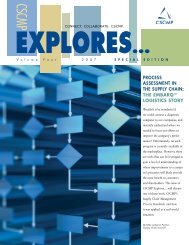Return Profits From Returns: Leveraging all 5 R's - Supply Chain ...
Return Profits From Returns: Leveraging all 5 R's - Supply Chain ...
Return Profits From Returns: Leveraging all 5 R's - Supply Chain ...
Create successful ePaper yourself
Turn your PDF publications into a flip-book with our unique Google optimized e-Paper software.
Receipt of the returned product is integral to the returns process. While using an effective RMA<br />
process and troubleshooting can greatly reduce the number of returns a company gets back,<br />
volumes will still probably fluctuate which can ch<strong>all</strong>enge staffing levels. <strong>Return</strong>ed product<br />
should come back with bar codes that can be scanned to minimize handling. In addition, some<br />
companies are turning to innovative transportation methods to help speed the receipt of goods.<br />
One method companies are starting to explore is to consolidate repairs coming back into larger<br />
shipments. Companies can reduce transportation costs by coordinating returns shipments with<br />
larger shipments.<br />
Once companies have a returned product in their possession, the item can spend days, weeks,<br />
even months on a shelf waiting to be evaluated because this process is often done on a caseby-case<br />
basis. The testing, sorting, and grading of returned products are labor-intensive and<br />
time consuming tasks. The process can be streamlined if a company subjects the returns to<br />
quality standards and uses sensors, bar codes, and other technologies to automate tracking<br />
and testing. xiii<br />
Processing a return involves updating companies systems to both check the product back into<br />
inventory as well as give credit authorization to the customer. Some companies are starting to<br />
integrate this activity within the distribution center to speed up the process.<br />
One of the most effective steps a company can take with regards to supporting the smooth flow<br />
of product to its appropriate place is to perform product disposition based on predefined<br />
business rules. Demands for faster support – especi<strong>all</strong>y for spare parts either that need to be<br />
sent to a customer or used in the repair process – are becoming a key priority. A recent study<br />
found that nearly 70% of respondents indicated that the typical aftermarket service response<br />
times required in service level agreements (SLAs) have shrunk to 48 hours or less. This<br />
translates to the need for outstanding logistics processes that can support the various channels<br />
and customer needs associated with a returned product – whether doing a simple replacement<br />
or managing a complex repair.<br />
When the re-boxing of product returns is appropriate, the DC should have an inventory of<br />
vendor/supplier boxes, tape, shrink wrap, strapping and other vendor-specific materials<br />
available to employees/associates at returns processing stations. xiv<br />
While customers are demanding rapid service for their returns or repairs, many companies have<br />
not been able to efficiently manage these expectations. This is especi<strong>all</strong>y true with regards to<br />
managing spare parts needed to make repairs. A recent study shows an on-time delivery<br />
performance of 89%, and first-time fill rates of 82% for spare parts. This performance might<br />
seem acceptable –even good. However, such sub-90% performance can negatively impact<br />
customer satisfaction and over<strong>all</strong> profitability, especi<strong>all</strong>y when it means a customer needs a<br />
critical part for a repair. Research shows, on average, companies experience 272 service parts<br />
stock outs each year, a typical company may potenti<strong>all</strong>y lose more than 270 customers xv<br />
Repair Management<br />
As Dave Vehec, VP of retail service at GENCO<br />
points out, “There is value in products”.<br />
Unfortunately, Mr. Vehec also adds, “the longer it<br />
sits, the less value you’re going to have in that<br />
product”. xvi Companies should shift their thinking<br />
from associating returns as a headache and view it as a reselling opportunity for profit. Firms<br />
that do product refurbishing can reap significant benefits. Recovery rates (as a percent of the<br />
dollar value of the product) for refurbished or remanufactured items can be quite high compared<br />
5




